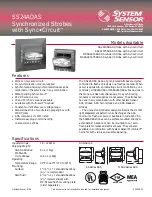
Document: LT0439 Vigilant
MX1-Au
Operator Manual
Issue 1.73
23 October 2018
Page 1-17
service agent.
Auto-Reset
An in-situ detecto
r test mode (sometimes called “Walk Test”), which
allows detectors to be alarm tested in their installed positions. The
zone is disabled and detector algorithms are bypassed to allow the
detector to go into alarm quickly. The detector is automatically reset
to allow the next detector in the zone to be tested.
Base Display
This is the display shown without operator intervention, or when the
CANCEL key has been held or pressed a number of times to get
back to the top display. The
MX1
may be showing normal, faults,
disables. The Alarm List is a special base display (but is not classified
as the Base Display in this manual).
CO
Carbon Monoxide
– a colourless poisonous gas that moves by
diffusion, emitted by smouldering fires.
Dirty
[detector]
Smoke detectors can become contaminated due to a buildup of dust,
dirt and other foreign particulates inside the sensing chamber.
MX1
monitors the detector reading as it increases due to dirt buildup, and
compensates by shifting the alarm threshold to maintain a consistent
sensitivity to smoke. It signals a dirty state for the detector when this
reading indicates that the level of contamination is such that it can no
longer be compensated for.
From this point onward (until the detector is cleaned and replaced) it
is more sensitive to smoke and thus more likely to produce a
nuisance alarm.
FRC
Flat ribbon cables, usually internal to the c.i.e. cabinet.
Nuisance
alarm
An alarm condition that occurs without the presence of a fire.
Off-normal
(point)
The point is in a condition other than normal, for example fault,
disabled, active, etc.
Off-normal
(system)
A system condition where there is one or more points or zones that
are not normal. That is, a point or zone has a status other than
normal
– for example, Fault, Alarm, Dirty, or Device Fail.
Residential
Mode
A configuration where a smoke detector alarm does not activate the
alarm devices and alarm routing. Only a warning local to the
originating detector is given.
This manual includes a number of example
MX1
LCD displays. The
information shown in most of these is defined by the site-specific data
used, and so may differ for each installation.
Nuisance alarms (also called false alarms or unwanted alarms) are alarm
conditions caused by events other than a fire. These can be generally
categorised according to two causes:
The detector has correctly sensed the phenomena it is designed to
detect, but the reason for the phenomena being present is not a fire.
Examples are: a heat detector being triggered by very hot air from an
oven, hot outside air entering an air-conditioned foyer, smoke from an
outside fire triggering a smoke detector in the building, or welding
setting off a flame detector.
Example
Displays
Nuisance Alarms






































